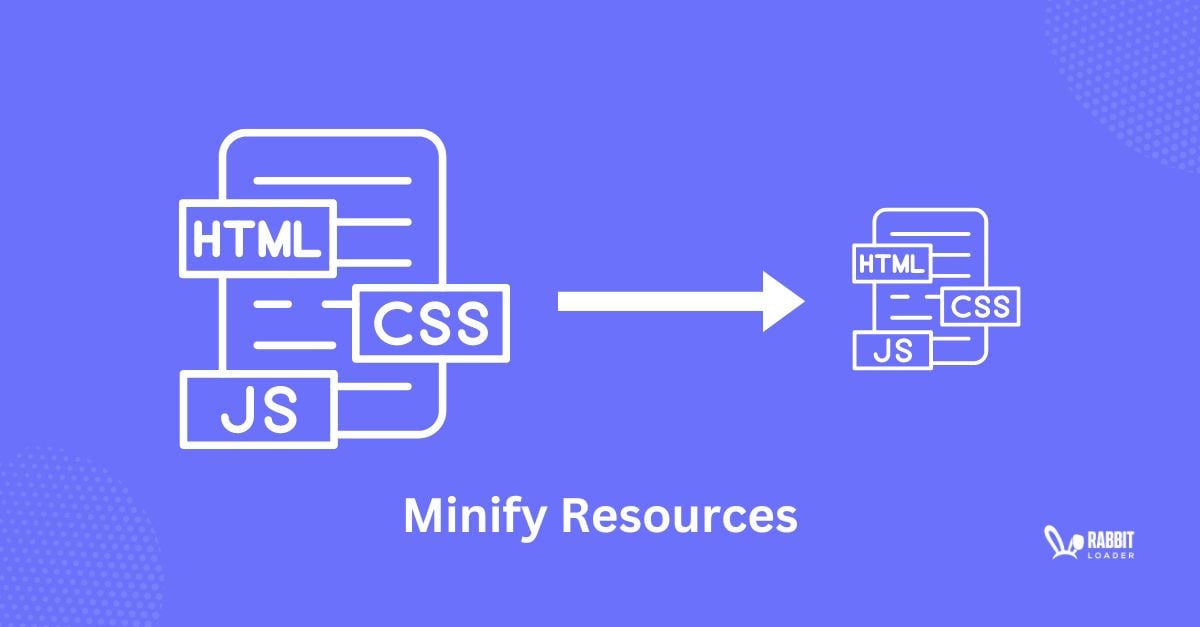Get The Best PageSpeed Score
For Your WordPress Website

How To Minify Resources (CSS, JavaScript, And HTML) Easily
Minify resources such as CSS, JavaScript, and HTML does improve WordPress website’s page speed score, but can you do it on your entire website?
During the audit of your website’s pagespeed performance in Google PageSpeed Insights, you often notice the most common warnings: “Minify CSS” and “Minify JavaScript”.

It is probably the easiest of the suggested improvements to implement on your website. If you want to do the task manually, you can easily minify resources (CSS, JavaScript, and HTML) by removing spaces, line breaks, comments, and other unnecessary characters.
Let’s discuss minification in detail and explore how RabbitLoader can help you minify resources on your entire website without any manual actions.
What Is Resources Minification?
CSS, JavaScript, and HTML files are your website’s primary resources. However, due to their large size, these files sometimes harm the pagespeed of your website.
To understand it with an example, when a developer writes stylesheet (css) code,to make the code readable, the developer would often use characters like line breaks, spaces, comments, and meaningful variable names.
It is similar to a word document or this article, where the spaces do not necessarily change the meaning of the text, but without these, it would be very hard for you to read the article.
While these spaces are, comments, line breaks are necessary for us humans to be able to read the code, these are not necessary for the browser. So shedding them would help your webpages lose some weight. Which would result in a slightly faster loading website.
Example of CSS Minification
CSS is an essential resource for your website. It adds style elements to your webpages. Color, size, font style, margin, and many other properties are handled by the CSS.
In the section below you can see some CSS which includes comments, line breaks, and spaces are used to help readers better understand the code during review.
However, browsers don’t need these unnecessary characters in your code during web page rendering.
Syntax
/* styling the paragraph */
p {
font-family: Arial;
color: red;
background-color: white;
}
/* links are here */
a: link {
color: blue;
}
a: visit{
color: grey;
}CSS minification means reducing the size of a CSS file to the smallest size by removing the unnecessary characters from the original size without affecting its functionality and the web page’s design.
So here’s how the same code would look after minification.
Minified CSS code:
p{font-family:Arial;color:red;background-color:grey;}a:link{color:blue;}a:visited{color:grey;}
Example of JavaScript Minification?
JavaScript improves the user experience of your website by adding interactivity. Let’s see how the developer writes code in a JavaScript file to return a random number.
// return a random number between 1 and 6
function dieToss() {
return Math.floor(Math.random() * 6) + 1;
}
// function returns a promise that succeeds if a 6 is tossed
function tossASix() {
return new RSVP.Promise(function(fulfill, reject) {
var number = Math.floor(Math.random() * 6) + 1;
if (number === 6) {
fulfill(number);
} else {
reject(number);
}
});
}
// display toss result and launch another toss
function logAndTossAgain(toss) {
console.log("Tossed a " + toss + ", need to try again.");
return tossASix();
}
function logSuccess(toss) {
console.log("Yay, managed to toss a " + toss + ".");
}
function logFailure(toss) {
console.log("Tossed a " + toss + ". Too bad, couldn't roll a six");
}
// use promise paradigm to try three times to toss a 6
tossASix()
.then(null, logAndTossAgain) //Roll first time
.then(null, logAndTossAgain) //Roll second time
.then(logSuccess, logFailure); //Roll third and last timeJavaScript minification is an optimization technique that removes unnecessary characters from the original JavaScript files and reduces their size.
If we minify the above JavaScript code, it looks like this:
function dieToss(){return Math.floor(6*Math.random())+1}function tossASix(){return new RSVP.Promise(function(a,b){var c=Math.floor(6*Math.random())+1;6===c?a(c):b(c)})}function logAndTossAgain(a){return console.log("Tossed a "+a+", need to try again."),tossASix()}function logSuccess(a){console.log("Yay, managed to toss a "+a+".")}function logFailure(a){console.log("Tossed a "+a+". Too bad, couldn't roll a six")}tossASix().then(null,logAndTossAgain).then(null,logAndTossAgain).then(logSuccess,logFailure);Example of HTML Minification.
HTML is a core resource of your website. It is used to create your website’s content. When rendering your website, browsers first ask for an HTML file. When developers use extra characters, the file size automatically increases.
For example,
<html lang="en-US">
<head>
<meta charset="utf-8" />
<meta name="viewport" content="width=device-width" />
<!--adding an title-->
<title>My test page</title>
</head>
<body>
<!--adding an image-->
<img src="images/firefox-icon.png" alt="My test image" />
</body>
</html>HTML minification is an optimization process to make your HTML code more compact to ensure that the HTML files are parsed and delivered more quickly.
After HTML minification, the HTML code looks like below:
<html lang="en-US"><head><meta charset="utf-8"><meta name="viewport" content="width=device-width"><title>My test page</title></head><body><img src="images/firefox-icon.png" alt="My test image"></body></html>The Importance Of Minifying CSS, JavaScript, And HTML
Resources (CSS, JavaScript, and HTML) minification is an essential pagespeed optimization technique for improving web page loading time, boosting your Largest Contentful Paint (LCP), and reducing page size. Let’s understand it in detail.
- Improve Page Loading Time
According to Huckabuy, Website conversion rates drop by an average of 4.42% for extra sec of load time between 0 and 5 seconds. Therefore, pagespeed is just like money for a website owner.
By minifying your CSS, Javascript, and HTML files, you can increase the page loading time, which will improve your average on-page time and conversion rate by reducing your bounce rate.
- Boosts Your Largest Contentful Paint
Largest Contentful Paint (LCP) calculates how long the browser takes to render the largest contentful element (a text block or the hero image) of your website.
By minifying your resource files, you can easily improve your LCP performance and mitigate the most common Google PSI warning, reduce initial server response time.
- Reduce The Page Size
You often encounter the Avoid Enormous Network Payloads warning during the PageSpeed audit due to your large page size.
By minifying CSS and JavaScript along with HTML files, you can reduce the page size, mitigate this warning, and speed up your website.
The Difference Between Minification And Compression
The main goal of both optimization techniques: minification and compression is almost the same, reducing the HTML, CSS, and JavaScript files. However, based on the reducing process of the resources file’s size, minification differ from the compression.
As discussed earlier, minification is an optimization process to remove unnecessary characters from the resource files. On the other hand, compression is the process of replacing the repeated string with a pointer to reduce the overall page size.
Minifying Your Resources With RabbitLoader
If you are looking for an effortless solution, RabbitLoader is your saving grace.
When you install RabbitLoader, it will automatically minify your HTML, CSS, and JavaScript files along with the other optimization techniques. You don’t need extra effort or plugin to minify resources.
Not only WordPress websites, you also can speed up your WooCommerce, Shopify, Laravel, and PHP websites by using RabbitLoader.
Get The Best PageSpeed Score
For Your WordPress Website
If you wish to test minification on one or two pages of your website, to check if minifying resources can improve your website’s pagespeed or not, you can use the below minification tools.
However, if you have a large website, it takes a huge time to minify the web pages individually. In this case, you are better off with a plugin like RabbitLoader to improve the Pagespeed.
Check Also: Minify Php
How To Minify CSS, Javascript, And HTML
Several online minification tools are available to optimize your pagespeed performance.
What are The Best Tools For Minifying CSS?
Here we mention three CSS minification tools.
- CSS minifier
- UnCSS
- CleanCSS
CSS minifier
CSS minifier is an online CSS minification tool where you can customize your minified files such as your compression type. Paste your CSS code to minify your CSS file.

UnCSS
Apart from this CSS minification, UnCSS also removes your unused CSS file and reduces the page size of your CSS file.

CleanCSS
CleanCSS is a very user-friendly CSS minification tool. To minify your CSS file, just paste your URL.

What are The Best Tools For Minifying JavaScript?
- YUI compressor
- Uglify JS
- JSMin
YUI compressor
YUI compressor is a user-friendly CSS and JavaScript minification tool. It looks at the source JavaScript file to see how it was made. Then, it eliminates as many white space characters as it can and replaces all local signals with 1 (or 2, or 3).

Uglify JS
UglifyJS is one of the most widely used tools for minifying JavaScript. This tool allows JavaScript code to be parsed, minified, and compressed.

JSCompress
By using this tool, you can minimize your JavaScript files by 80%. In order to minify and compress your JavaScript file, JSCompress use uglifyJS and babel-minify.

What are The Best Tools For Minifying HTML?
- HTML Minifier
- Minify
- HTML Compressor
HTML Minifier
HTML Minifier allows you to reduce your HTML file size by removing comments, line breaks, space, and other unnecessary comments.

Code Beautify
Code Beautify is a command-line HTML minification tool. You can upload or paste your HTML code, and this tool will reduce the size of your HTML file.

HTML Compressor
HTML compressor is a simple HTML minification tool that remove the unnecessary comments, whitespace and shortening your variable name.

Conclusion
Minification of resources (CSS, JavaScript, and HTML) are crucial optimization techniques for speeding up your website. Using a solution like RabbitLoader would surely minify resources and help you achieve a good pagespeed for your website.
If you are struggling with your slow-loading website, it’s probably the best time to try RabbitLoader today.
Get The Best PageSpeed Score
For Your WordPress Website